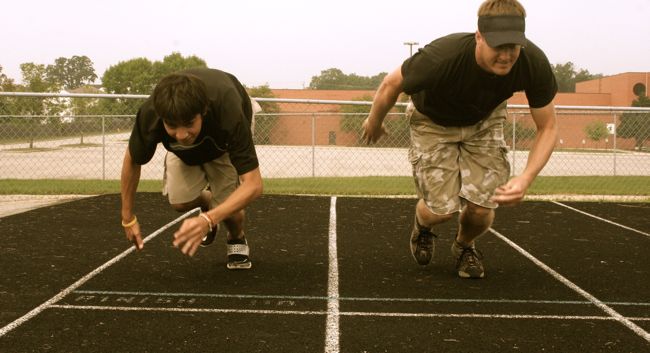
1. Use proper posture
If your athlete is running with his arms swinging from side to side, he is suffering from teenage kid syndrome. This means he spends too much time working on the muscles in the mirror (chest and biceps) and not enough on his back, glutes, and hamstrings. He also slouches a lot and walks with his head down all the time. This will cause a severe pronation of the scapula and will cause his knuckles to face inward, which will then cause him to swing his arms from side to side. Improving the player’s posture relies heavily on the player and not so much on the coach. You can do what you can with the limited time you have with the player, but the real improvements come when he is on his own.
At the gym, have him work on a lot of scapular retraction movements and have him stretch out the pecs with static movements. Have him deadlift with his hands in a supinated grip, which means his palms are facing away from his body. Deadlift with light weight, really retract at the top position, and hold for about three seconds. This exercise and many others are great ways for your athlete to improve his posture. But like I said, an athlete has to work hard on his own to alleviate the problem. Everywhere he goes he should be sticking his chest out and trying to retract his shoulder blades. He also needs to be sitting up in class and retracting his shoulder blades. Try these out with your athletes and see their 40 times improve.
2. Increase stride length
This is easy. The fewer steps you take, the faster your 40 time will be. To improve this, many coaches tell their players to do high knees, but that is the wrong information to give. You need to have your players drive their legs back. This will cause the player to lengthen his stride and it will also increase his rate of force development. This can be achieved by hill sprints or sled drags.
3. Set up proper shin angle
A player’s shin should be at a 45-degree angle when lifted up in a dorsi flexed manner. This is like loading a spring. As soon as the foot hits the pavement, it will spring up and cause the rate of force development to increase, which will help your athlete increase hip flexion.
4. Increase rate of force development
This is easy. The stronger and more explosive your athlete, the more force he will generate. So get your athletes in the weight room lifting heavy things and out on the field doing explosive plyometrics and medicine ball throws. You need a plan in the weight room as well as on the field. Don’t train your athletes like endurance athletes and make them run all day and don’t train them to be powerlifters. Set up your program so they can become better football players, but make sure they’re getting stronger.
5. Decrease body fat
You can’t move fast if you’re carrying extra fat. This is common knowledge. So make sure you’re eating right and fuel your body with healthy food. The days of eating food because it tastes really good are over. That will only lead you to a slow 40 and a weak vertical jump. Feed your body as if it were a high powered machine.


6. Strengthen your hip flexors
The hip flexors are the key to sprinting faster, but they’re usually neglected in the US. The top runners in the world are from Jamaica, and they focus their training on the hip flexors. They do this by sprinting hills and performing weighted spread eagle sit-ups, leg raises with bands, and mountain climbers with bands. These are just a few examples, but anything that involves hip flexion will work.
Recently, researchers did a study with the fastest Japanese runner and Asafa Powell from Jamaica, one of the fastest men on the planet. The only difference they found between the two men was the size of the cross section of the iliopsoas, which is your hip flexor. The bigger the muscle cross section, the more force it can generate.











I think theres clear confusiin with your foot anatomy but i like the rest of the coaching advice. However you definately need to generate more striking force using the ball of your foot and shorter faster strides.